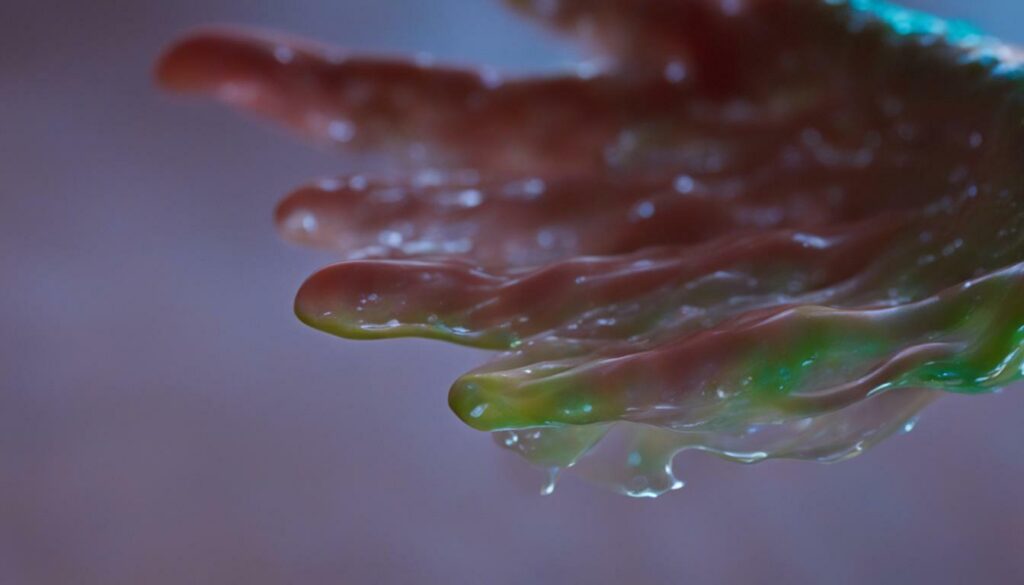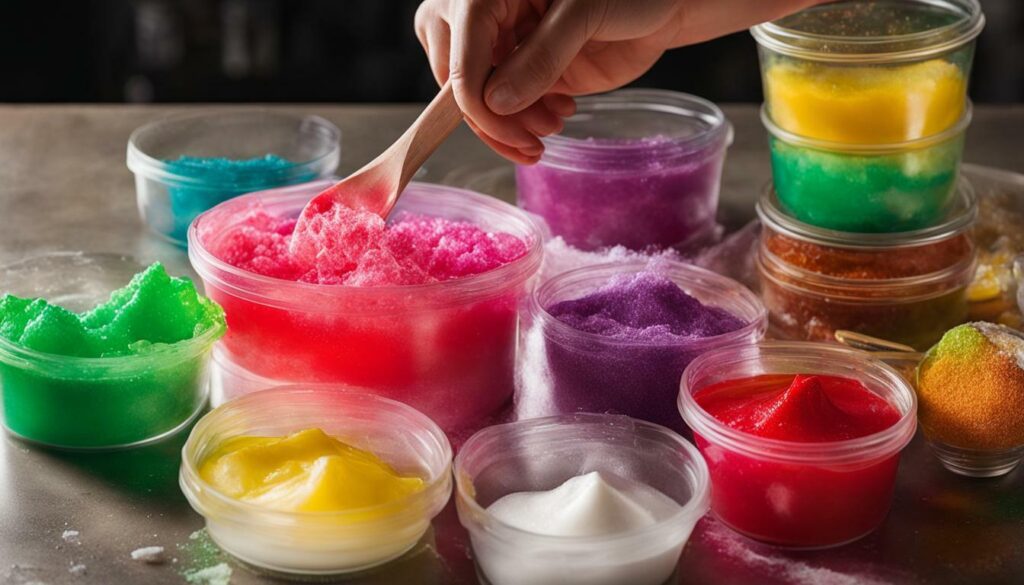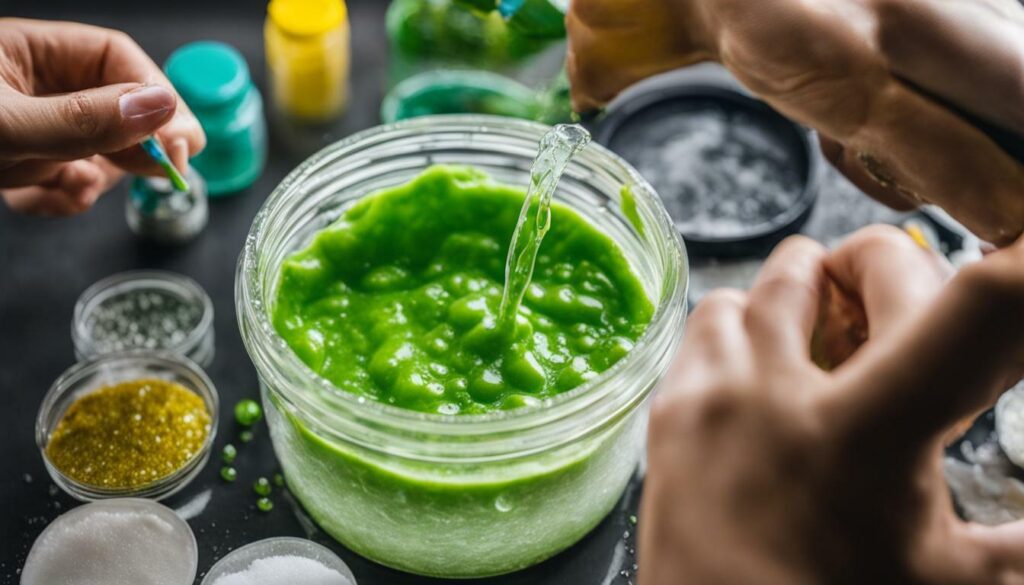Have you ever wondered why your slime feels wet, even though it’s not made of water? The fascinating world of slime has intrigued many DIY enthusiasts and curious minds. In this section, we will explore the reasons behind why slime feels wet and delve into the science behind its unique texture.
Key Takeaways:
- Slime feels wet due to the presence of certain ingredients that create a moist sensation.
- The consistency of slime plays a crucial role in its wetness level.
- Adjusting slime consistency can help control the wetness and stickiness of your slime.
- Troubleshooting common slime issues can lead to a more enjoyable slime-making experience.
- By understanding the science behind slime, you can create the perfect texture for your desired slime creations.
Understanding Slime Consistency
When making slime, getting the right consistency is crucial for an enjoyable sensory experience. The texture of your slime can greatly affect how it feels and how it behaves. Whether you prefer a stretchy, fluffy, or gooey slime, achieving the perfect consistency is key.
So, what can you do if your slime doesn’t have the desired texture? Let’s explore some common issues and their solutions:
- If your slime feels too watery, you can add more activator, pour off excess liquid, or add more glue.
- If your slime is too sticky, try adding more activator or something dry like cornstarch.
- If your slime is stringy, you may not have kneaded it enough.
- If your slime has too much borax, you can add more water and glue.
- If your slime has too much shaving cream, you can run it under cold water to remove the excess.
- If your slime is runny, you can try adding more glue or activator.
Experimenting with different ratios of ingredients and adjusting the consistency to your preference is part of the fun of making slime. Don’t be afraid to get creative and try new techniques!
“When it comes to slime, consistency is key. Finding the right balance of ingredients and achieving the desired texture can make all the difference in your slime-making adventures.”
Summing it Up
Understanding slime consistency is essential for creating a satisfying sensory experience. By adjusting the ratios of ingredients and experimenting with different techniques, you can achieve the perfect texture for your slime. Remember, if your slime is too sticky, watery, stringy, or runny, there are simple solutions to fix it. Get creative, have fun, and enjoy the process of making your own slime!
| Common Slime Issues | Solutions |
|---|---|
| Too watery | Add more activator, pour off excess liquid, or add more glue |
| Too sticky | Add more activator or something dry like cornstarch |
| Stringy | Knead it more |
| Too much borax | Add more water and glue |
| Too much shaving cream | Run it under cold water to remove excess |
| Runny | Add more glue or activator |


Exploring the Science of Slime
The science behind slime involves a fascinating combination of chemical reactions and physical properties. Slime is made by mixing together a few key ingredients, such as glue, water, and an activator like borax or contact lens solution. When these ingredients interact, they undergo a process called crosslinking, which creates long chains of molecules that give slime its unique texture.
One of the main components of slime is a type of polymer called polyvinyl alcohol, which is found in the glue. When the activator is added to the glue, it causes the polyvinyl alcohol molecules to link together, forming a network. This network traps the water molecules, creating a slimy, wet feeling.
Additionally, the presence of the activator also affects the consistency of the slime. The activator reacts with the polyvinyl alcohol, causing chemical bonds to form between the molecules. These bonds give the slime its stretchy, elastic properties. The more activator that is added, the stronger these bonds become, resulting in a firmer slime.
Understanding the science behind slime can help you troubleshoot common issues you may encounter when making it. If your slime feels too wet or watery, you can add more activator to strengthen the bonds and reduce the water content. On the other hand, if your slime is too sticky, adding a dry ingredient like cornstarch can help absorb some of the excess moisture. By experimenting with different ratios of ingredients and understanding how they interact, you can achieve the perfect slime consistency.
Now that we’ve explored the science behind slime, let’s move on to the next section and discover some useful tips for making your own slime at home.
| Slime Troubleshooting Tips |
|---|
| If your slime feels too watery, add more activator or pour off excess liquid. |
| If your slime is too sticky, add more activator or something dry like cornstarch. |
| If your slime is stringy, knead it more to strengthen the bonds between the molecules. |
| If your slime contains too much borax, add more water and glue. |
| If your slime has too much shaving cream, run it under cold water to remove the excess. |
| If your slime is runny, try adding more glue or activator to thicken it. |
Tips for Making the Perfect Slime
Ready to dive into the world of slime making? Here’s everything you need to know to create the perfect slime.
When making slime, it’s important to get the right consistency. If your slime feels too watery, you can add more activator, pour off excess liquid, or add more glue. If your slime is too sticky, try adding more activator or something dry like cornstarch. If your slime is stringy, you may not have kneaded it enough. If your slime has too much borax, you can add more water and glue. If your slime has too much shaving cream, you can run it under cold water to remove the excess. If your slime is runny, you can try adding more glue or activator.
To make the perfect slime, start with your choice of glue. Clear glue or white school glue are popular options. Add your desired color or glitter for a fun twist. Then, slowly mix in the activator, like borax or contact lens solution, until the slime starts to come together. Knead the slime with your hands until it’s no longer sticky and has a smooth consistency. You can even add fun add-ins like beads or foam balls to create a unique texture.
Experiment with different slime recipes and ingredients to find your favorite. Whether you prefer fluffy slime, crunchy slime, or slime that changes color, there’s a recipe out there for you. Don’t be afraid to get creative and customize your slime with scents or textures. Remember, practice makes perfect, so don’t be discouraged if your first attempt doesn’t turn out exactly as planned. Keep experimenting and have fun with the process!


| Common Slime Issues | Solutions |
|---|---|
| Slime feels too watery | Add more activator, pour off excess liquid, or add more glue |
| Slime is too sticky | Add more activator or something dry like cornstarch |
| Slime is stringy | Knead it more |
| Slime has too much borax | Add more water and glue |
| Slime has too much shaving cream | Run it under cold water to remove excess |
| Slime is runny | Try adding more glue or activator |
Helpful Tips:
- Start with the right glue for your desired slime consistency
- Add activator slowly, as a little goes a long way
- Knead your slime thoroughly to achieve the desired texture
- Experiment with different colors, glitters, and add-ins for unique slime creations
- Store your slime in airtight containers to keep it fresh and prevent drying out
Troubleshooting Common Slime Issues
Don’t let common issues dampen your slime-making enthusiasm! Here are some troubleshooting tips to help you overcome challenges.
If your slime feels too watery, you can try adding more activator, pour off excess liquid, or add more glue. It’s all about finding the right balance of ingredients to achieve the desired consistency. Experiment with small adjustments until you get the perfect texture.
On the other hand, if your slime is too sticky, don’t panic! You can easily fix it by adding more activator or incorporating something dry like cornstarch. Adding these ingredients will help absorb the excess moisture and make your slime less sticky.
Another common issue is when your slime turns out stringy instead of smooth and stretchy. This often happens when the slime has not been kneaded enough. Spending a few extra minutes kneading the slime can help break down the stretchy strands and create a more cohesive texture.


Sometimes, you may find that your slime has too much borax or shaving cream, resulting in an unbalanced consistency. In these cases, you can adjust the slime by adding more water and glue or rinsing it under cold water to remove the excess shaving cream. Remember, a little tweaking can go a long way!
Lastly, if your slime is runny and not holding its shape, try adding more glue or activator to thicken it up. The key is to gradually add the ingredients and mix well until you achieve the desired texture.
| Issue | Troubleshooting Tips |
|---|---|
| Slime feels too watery | – Add more activator – Pour off excess liquid – Add more glue |
| Slime is too sticky | – Add more activator – Incorporate something dry like cornstarch |
| Slime is stringy | – Knead it more to break down the strands |
| Too much borax or shaving cream | – Add more water and glue – Rinse under cold water |
| Slime is runny | – Add more glue or activator gradually |
Achieving the Ideal Slime Texture
Achieving the perfect slime texture is within your reach! Let’s explore the techniques for achieving an ideal slime consistency.
When it comes to making slime, getting the right consistency is key. If your slime feels too watery, don’t worry! You can easily fix it by adding more activator or pouring off the excess liquid. Alternatively, adding more glue can also help thicken it up.
On the other hand, if your slime is too sticky, there’s a simple solution. Try adding more activator or something dry like cornstarch. These ingredients will help absorb the excess moisture and make your slime less sticky.
Stringy slime can be a common issue, but fear not! The problem is often due to not kneading the slime enough. Simply spend a few more minutes kneading and stretching the slime until it becomes smooth and less stringy.
It’s also important to keep in mind that certain ingredients can affect the texture of your slime. If your slime has too much borax, adding more water and glue can help balance it out. Likewise, if your slime has an excess of shaving cream, running it under cold water can remove the excess and improve its consistency. And don’t forget, if your slime is runny, adding more glue or activator can help thicken it up.
With these tips and tricks, you’ll be able to create that perfect slime consistency every time. Remember, practice makes perfect, so don’t be afraid to experiment with different ingredients and ratios. Now, go ahead and get creative with your slime making!
